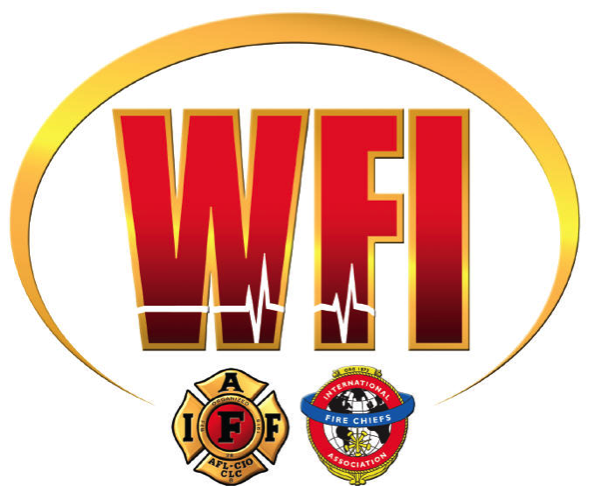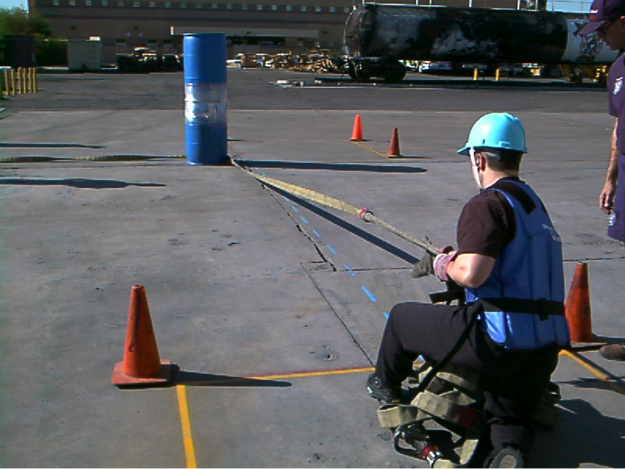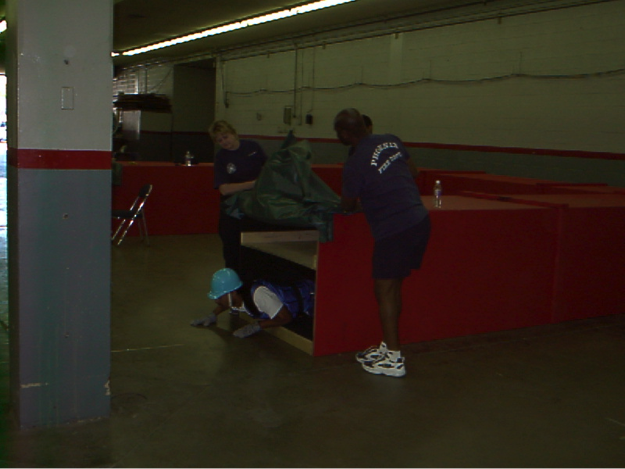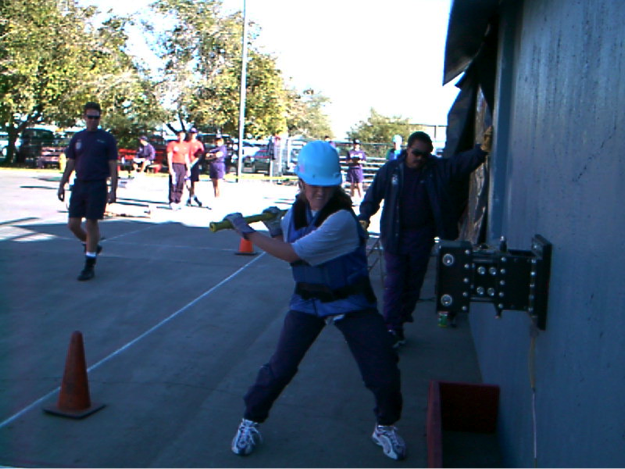
Fire Service Joint Labor Management
Wellness-Fitness Task Force
Candidate Physical Ability Test Program Summary
The IAFF/IAFC Wellness-Fitness Task Force
The IAFF and IAFC have teamed up with 10 of North America’s leading fire departments and unions through the Fire Service Joint Labor Management
Wellness/Fitness Initiative to develop the IAFF/IAFC Candidate Physical Ability Test (CPAT). The participating departments on the Task Force are:
Austin, TX / IAFF Local 975
New York City, NY / IAFF Local 94/854
Los Angeles Co., CA / IAFF Local 1014
Fairfax Co., VA / IAFF Local 2068
Calgary, ALB / IAFF Local 255
Phoenix, AZ / IAFF Local 493
Metro Dade Co., FL / IAFF Local 1403
Indianapolis, IN / IAFF Local 416
Charlotte, NC / IAFF Local 660
Seattle, WA / IAFF Local 27
The Task Force successfully developed the Fire Service Joint Labor-Management Wellness-Fitness Initiative in 1997 to address the need for a holistic and
non-punitive approach to wellness and fitness in the fire service. The Task Force then discovered that municipalities were hiring people who would not be
physically capable of a successful career in the fire service. The Task Force, therefore, unanimously agreed to develop a physical ability test for pre-employment
testing of candidates. The Task Force has developed and validated the Candidate Physical Ability Test (CPAT), resulting in a consistent test for hiring of
candidate fire fighters.
Developing the CPAT
The Task Force directed the Technical Committee to develop a performance test for the ten jurisdictions that measures the critical skills of fire fighter candidates.
Committee members reviewed six of the ten jurisdictions job analysis and job task surveys. They also reviewed each of the ten jurisdiction’s current candidate performance
tests and job descriptions. Additionally, a complete equipment and demographics survey was also completed by the ten jurisdictions. The equipment survey provided
types and weights of all fire fighter protective clothing, protective equipment, fire department equipment and fire department tools. It also assessed the average weight
of fire fighters in each jurisdiction as well as the average weight of emergency room and hospital admitted patients. Demographic profiles of each jurisdiction were also
developed.
Using the data collected, the Committee then derived a list of 31 tasks to investigate. They developed survey questions directly related to these 31 tasks.
The critical and physical task skills that all fire fighters should possess were validated (through questionnaires) by 1,000 fire fighters from the ten departments.
Selection of the 1,000 fire fighters was random and anonymous, but consistent with the race and gender diversity of the specific department. The completed results of
the surveys resulted in the development a series of physical ability tests that were selected based on the results of the data indicating the physicality and
criticality of the tasks performed by fire fighters.
Props for each event were built and modified to obtain the necessary information regarding candidate’s ability. The props were then placed in a sequence that would best
simulate their use in a fire scene. The Technical Committee chose to move the candidates along a predetermined path from event to event in a continuous manner requiring
a mandatory walk between events.

Because of the test set up, individual event times would be an ineffective measure of a candidate’s ability, so an overall test time needs to be established. Numerous
individuals were run through the test including: technical staff members, incumbent fire fighters, lay people and a recruit class.
The overall consensus found the test to be a good predictor of an applicant’s ability to perform basic fire fighting tasks. The Technical Committee was confident that the ability test
would provide the fire service with a physically competent recruit. There was also unanimous agreement that the test equaled or was superior to current test run by each
of the ten jurisdictions.
These tests were filmed at different speeds and presented to supervisors in the 10 jurisdictions (captains and battalion chiefs with experience in fire fighter training).
At the completion of this process an entry test was finalized and presented to the Task Force for adoption. The Task Force unanimously adopted the full Candidate Physical
Ability Test with a pass/fail time of 10 minutes and 20 seconds. The test may only be administered on a pass/fail basis, municipalities may not rank candidates based
upon CPAT completion times.

Administering the CPAT
In developing the CPAT Program, the Task Force recognized that the fire department should reflect the community it serves. In today’s society, communities are
increasingly diverse and fire fighters are continually challenged to operate in multi-cultural environments. The goal of the CPAT is to test for those individuals
physically qualified to perform the job of fire fighter without separating from the department’s broader goal of attaining a properly trained and physically capable
workforce whose members reflect the diversity of the community. Diversity should never come by lowering validated entry standards. Rather, it should come from
actively recruiting qualified men and women candidates from all racial and ethnic backgrounds for careers in the fire service. It is the position of the IAFF/IAFC
Joint Labor Management Wellness-Fitness Initiative Task Force that fire departments should increase the diversity of their workforce by actively recruiting candidates
from throughout their communities rather than lowering candidate physical ability standards. The CPAT Program details avenues fire departments can pursue to raise
awareness of job opportunities and to recruit and mentor qualified candidates within the fire service before the test is administered.

The CPAT goal was to develop a fair and valid evaluation tool in the selection of fire fighters to ensure that all fire fighter candidates possess the physical
ability to complete critical tasks effectively and safely. This CPAT Program covers every aspect of administering the CPAT: from recruiting and mentoring programs, to
providing recruits with fitness guidance to help prepare them for the CPAT, to setting up and administering the test. The entire validation process is discussed in detail,
as well as the legal issues that departments might face when implementing the actual program.

In 2006, the following orientation and pre-test procedures were implemented after a conciliation agreement with the US Equal Employment Opportunity Commission (EEOC):s
All candidates will attend at least two mandatory orientation sessions commencing within eight weeks before the actual official CPAT test date, during which
they will receive "hands on" familiarity with the actual CPAT apparatus. Candidates may voluntarily attend up to one additional orientation session.
Within 30 days prior to the actual CPAT test date, all candidates will perform at least 2 timed practice runs, using actual CPAT apparatus, and in which the candidate is allowed to take as much time as necessary to complete the entire course.
A candidate may waive all of the fore-mentioned program components and be eligible to participate in a CPAT test. Such a waiver shall only be acceptable if it is in writing, and is made on a wholly knowing and voluntary basis.
During the orientations and practice runs certified Peer Fitness Trainers, fitness professionals and/or CPAT trained fire fighters (proctors) will be present to help all candidates understand the test elements and how they can improve their physical performance and conditioning prior to taking the test.
Further, the WFI Task Force now requires that all those that are licensed to use the CPAT must fully implement these orientation and pre-test procedures. For those fire departments that are utilizing another Licensee to conduct their CPAT, the fire department, as the employer, must ensure that these changes are incorporated.
After a municipality has completed all aspects of recruiting and mentoring candidates they may administer the actual eight-event test. During the entire test the candidate must wear a 50 lb. weighted vest (simulating the weight of a fire fighters protective clothing and equipment). The eight events are:
• Stair Climb (climbing stairs while carrying an additional 25 lb. simulated hose pack).
• Ladder Raise and Extension (placing a ground ladder at the fire scene and extending the ladder to the roof or a window).
• Hose Drag (stretching uncharged hoselines, advancing lines).
• Equipment Carry (removing and carrying equipment from fire apparatus to fireground).
• Forcible Entry (penetrating a locked door, breaching a wall).
• Search (crawling through dark unpredictable areas to search for victims).
• Rescue Drag (removing victim or partner from a fire building).
• Ceiling Pull (locating fire and checking for fire extension).
The Wellness/Fitness Initiative and the Candidate Physical Ability Test Program have been reviewed and utilized by fire departments throughout the U.S. and Canada. Each of the Task Force jurisdictions has also served as a resource and has assisted fire departments in their region with the adoption of these programs. An updated Wellness/Fitness Initiative and the Candidate Physical Ability Test is available through the IAFF and the IAFC.
